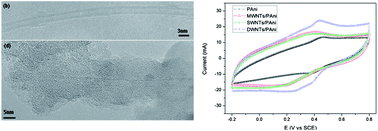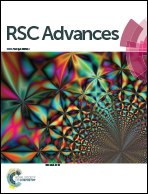Synthesis of a DWNTs/PAni composite and its supercapacitive behavior compared to the SWNTs/PAni and MWNTs/PAni composites
Abstract
Double walled carbon nanotubes (DWNTs) have unique coaxial structures and corresponding physical and chemical properties, making them good candidates for supercapacitor materials. However, there are almost no reports on DWNT based composites for supercapacitor applications. In this study, a DWNTs/PAni composite was synthesized by in situ chemical polymerization of aniline onto DWNTs, and its electrochemical performance as the electrode material in a supercapacitor was studied and compared to single-walled carbon nanotubes (SWNTs)/PAni and multi-walled carbon nanotubes (MWNTs)/PAni composites synthesized by the same method. TEM and SEM observations show that the PAni is uniformly coated on the DWNTs to form DWNTs/PAni bundles with diameters of about 100 nm. Raman characterization further indicates the strong interactions between the DWNT and PAni components in the DWNTs/PAni composite. Electrochemical analyses demonstrate that the DWNTs/PAni composite has not only significantly higher specific capacitance (576 F g−1) but also better cycling stability than the SWNTs/PAni and MWNTs/PAni composites. The excellent electrochemical performance of the DWNTs/PAni composite as the electrode material in a supercapacitor is attributed to the good charge transfer ability between the PAni and DWNT components, the comparatively large specific surface area of the DWNTs/PAni composite and the good stress and load transfer properties of DWNT due to its coaxial structure.


 Please wait while we load your content...
Please wait while we load your content...